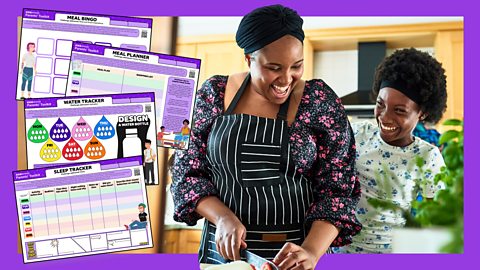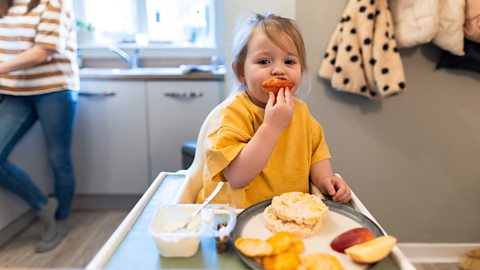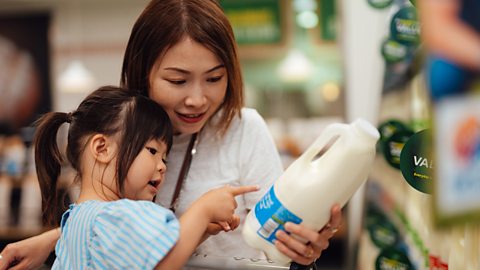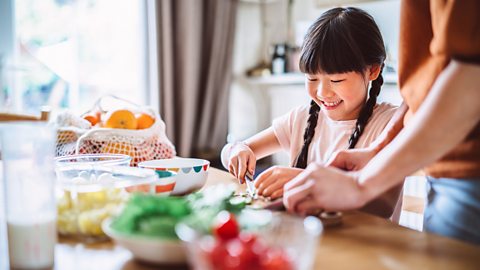According to the NHS, children in the UK are eating over twice the recommended amount of sugar, and half of it is coming from snacks and sugary drinks. Eating too much sugar can potentially lead to weight gain and tooth decay.
Snacks can be part of a normal healthy and balanced diet. The key is to offer a variety of snacks and for children to develop positive relationships with all sorts of different foods. There are some easy switches you can make for your child when it comes to snacking.
How many snacks should I give my child and when?
Snacks are important for children because they have small stomachs but need lots of energy and nutrients to grow. Below is a table with a suggested structure for meals and snacks for children. It’s recommended you set two snack times a day: one mid-morning and one mid-afternoon. Try to keep ninety minutes or more between eating times. This helps children to become hungry for their next meal.
| Breakfast | Snack | Lunch | Snack | Dinner | |
|---|---|---|---|---|---|
| 1-3yrs | 7:00am | 9:30am | 11:30am | 2:30pm | 5:00pm |
| 3-11yrs | 7:30am | 10:00am | 12:00pm | 3:00pm | 5:30pm |
| 11+ | 7:30am | 10:30am | 1:00pm | 3:30pm | 6:00pm |
You can change these snack times depending on what time your child wakes up, when they have a nap (if they do), what the childcare schedule is like (nursery, school or home), what your work schedule is like and what works for you. Read more on how food affects children’s sleep for advice on what and when to eat for good sleep.
What do I say if my child asks for food between meal times?
You could say 'snack time will be in half an hour' or 'dinner will be ready in 20 minutes', rather than giving them food to keep them going.
You might find your child gets frustrated if they don’t get the food they’re used to getting exactly when they want it. Children often test boundaries. It can be difficult, but if you stick to the times you’ve set, they’ll become used to the schedule and this will give them more freedom to enjoy playing and doing other things. Once they’ve learnt them, these boundaries will help them feel safe.
Quick tip: You could make a ‘kitchen closed’ sign together and decorate it. It could be 'open' for meal and snack times and 'closed' otherwise.
If you want to make quick and fun snacks for the kids, even when you are busy, we have some healthy snacks ideas you can make in under ten minutes!
What if we can’t keep to the set snack times?
If a snack is earlier or later than planned, due to activities or general life going on, that’s ok every now and again. This isn’t a rigid plan to make life difficult for you. It’s designed to help children learn that there are times to eat and times to do other things, in order to keep their bodies healthy.
What portion size should the snacks I give my child be?
Every child is different. The amount of food they eat will depend on lots of things: age, activity levels, what they eat at other times in a day. A handful is a good indicator for snack size because it grows with your child. If they eat that much and aren’t hungry for their next meal, offer a little less next time. If they’re often struggling to make it to the next meal without more food, offer them a slightly bigger snack.
What if my child doesn't want the snack I’ve offered?
That’s OK. Let them choose if they eat it or not. Try not to give them lots of other options and instead let them wait until the next meal. If they do this on a regular basis, it might be because they're having too much at meal times, they aren’t keen on what you’re offering or because they just don’t need the snack.
You could also let your child have a say in what snacks are available. This can make them feel more in control and more likely to eat. If they refuse the snack, put it away and offer it again later. Sometimes children may change their minds after some time. Get your child involved in preparing the snack too. They may be more willing to eat something they helped make or prepare. If you’re worried that they’re not eating enough and you’re concerned about their weight, have a chat with your health visitor, school nurse or GP.
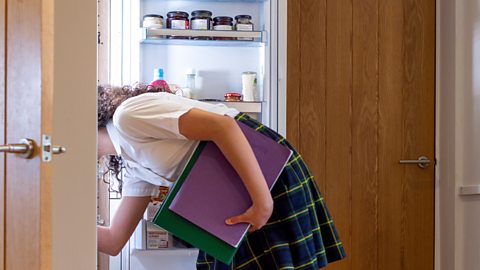
How many calories should my child have?
The number of calories just tells us the amount of energy in a food. We’ve given portion sizes for some of the snack ideas but these are only a guide. Every child is different. It's more important to focus on the nutritional quality of foods rather than just their calorie content. Nutrient-dense foods provide essential vitamins, minerals and other essential substances that support overall health and growth, which is essential for children. Teaching children to enjoy a variety of foods from different food groups helps them develop a positive relationship with food, focusing on how it nourishes their body rather than just the calorie content. Try to focus on getting a variety of foods which haven’t gone through too much processing.
Encouraging children to listen to their natural hunger and fullness signals also helps them regulate their intake more effectively than counting calories.

Ultimately we can’t control everything our children eat. There are always outside influences like birthday parties, play dates, sometimes grandparents or friends like to treat them, so remember that these things are ok. The best thing we can do is show that healthy foods are also enjoyable.
Find more information on what is a healthy amount of sugar, and understanding food labelling.
Advice and expertise across our Happy Family Eating content was provided by children’s dietitian Angharad Banner - an independent and NHS dietitian.

Parents' Toolkit
Fun activities, real-life stories, wellbeing support and loads of helpful advice - we're here for you and your child.

Happy Family Eating... a fun guide for parents
An overview of our detailed resources and guides to helping your child enjoy and understand their food
